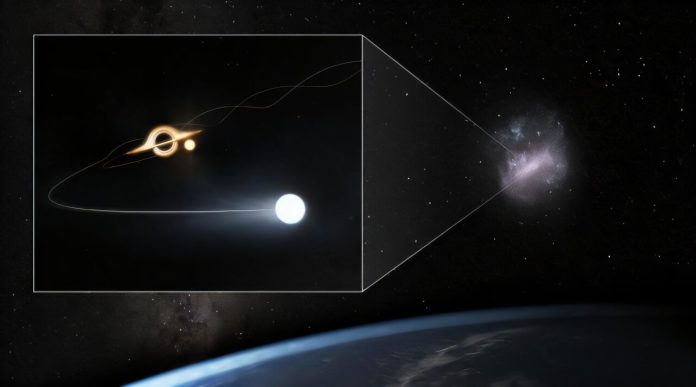
Astronomers have found strong evidence of a supermassive black hole in the Large Magellanic Cloud (LMC), a small galaxy near the Milky Way.
This newly identified black hole is the closest one known outside our galaxy.
The discovery was made by tracking 21 fast-moving stars known as “hypervelocity stars.” These stars are moving so quickly that they will eventually escape the Milky Way’s gravity.
Scientists traced their origins, much like forensic experts reconstruct the path of a bullet, and found something surprising.
About half of these hypervelocity stars were ejected from the supermassive black hole at the center of the Milky Way, as expected. However, the other half came from an unexpected source—an unknown black hole in the Large Magellanic Cloud.
“It is amazing that such a massive black hole has been hiding so close to us,” said Jesse Han of the Center for Astrophysics | Harvard & Smithsonian, who led the study.
“Black holes are extremely difficult to detect, so this one has been practically invisible until now.”
The team made this discovery using data from the European Space Agency’s Gaia mission, which has tracked more than a billion stars with incredible accuracy. They also used recent research on the movement of the LMC around the Milky Way.
Hypervelocity stars are created when a pair of stars passes too close to a supermassive black hole. The intense gravitational pull rips them apart—one star is captured by the black hole, while the other is flung away at millions of miles per hour.
The researchers predicted that a supermassive black hole in the LMC would create a cluster of hypervelocity stars in a specific region of the Milky Way. Their data confirmed this pattern, ruling out other possible explanations, such as supernova explosions or other star-ejecting events.
“The only explanation for this data is the existence of a giant black hole in our neighboring galaxy,” said co-author Scott Lucchini.
By analyzing the speed and number of ejected stars, scientists estimated that the LMC’s black hole is about 600,000 times the mass of our Sun. In comparison, the Milky Way’s black hole is much larger, with about 4 million solar masses. Some black holes in the universe are even billions of times heavier than the Sun.
The study will soon be published in The Astrophysical Journal, and a preliminary version is available on the arXiv preprint server.



